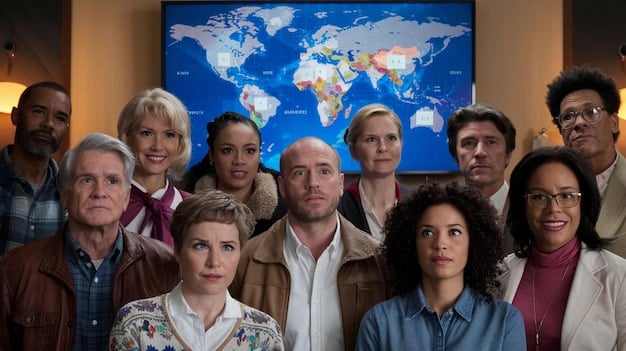US Balancing National Interests with Global Responsibilities?

The United States navigates a complex foreign policy landscape, continually attempting to reconcile its domestic priorities and national security with its declared commitment to global stability, human rights, and international cooperation.
The intricate dance between a nation’s self-interest and its broader role on the global stage is a perennial challenge for any major power. For the United States, this dynamic has defined much of its post-World War II foreign policy. The question of How is the US Balancing National Interests with Global Responsibilities? delves into the nuanced strategies, historical precedents, and ongoing dilemmas that shape America’s engagement with the world.
the foundational tension: national interests vs. global welfare
Understanding how the US attempts to harmonize its national interests with global responsibilities begins with acknowledging the inherent tension between these two poles. National interests typically encompass economic prosperity, national security, geopolitical influence, and the protection of its citizens, both domestically and abroad. Global responsibilities, conversely, extend to promoting democracy, human rights, environmental stewardship, humanitarian aid, and maintaining international peace and stability.
Historically, American foreign policy has swung like a pendulum between isolationism and interventionism. Following two world wars, a strong consensus emerged regarding the necessity of US leadership in shaping a liberal international order. This order, built on institutions like the United Nations, NATO, and the World Bank, was arguably designed to serve both US interests by fostering stability and global welfare by promoting cooperation.
economic objectives and global trade
One of the most clear-cut areas where national interests and global responsibilities intersect is in trade and economic policy. The US economy benefits immensely from global trade, and its prosperity is tied to open markets and stable supply chains worldwide. Simultaneously, American policies often aim to promote economic development in other nations, viewing this as a pathway to stability and reduced conflict.
- Promoting free trade agreements: The US has historically advocated for multilateral and bilateral trade agreements to expand market access for American goods and services.
- Supporting international financial institutions: Organizations like the International Monetary Fund (IMF) and the World Bank receive significant US support, aimed at fostering global financial stability and alleviating poverty.
- Addressing global supply chain vulnerabilities: Recent events have highlighted the need for diversification and resilience in supply chains, impacting both US economic security and global economic health.
However, the pursuit of domestic economic advantage can sometimes conflict with global responsibilities. For instance, protectionist trade measures, while intended to safeguard American jobs, can disrupt global trade flows and harm developing economies. Similarly, domestic subsidies for certain industries can distort international markets.
Striking this balance requires careful calibration. The US often uses its economic leverage to encourage other nations to adopt sustainable practices, labor standards, and good governance, demonstrating an effort to align its self-interest with broader global welfare objectives.
security imperatives and international cooperation
National security remains a paramount concern for any sovereign state, and for the US, this extends far beyond its borders. The nature of modern threats, from terrorism and cyberattacks to global pandemics and climate change, necessitates international cooperation.
The US maintains a powerful military, capable of projecting power globally, and it forms robust alliances, primarily through NATO and various bilateral agreements in the Indo-Pacific. These alliances serve both to deter aggression against the US and its allies, thereby protecting national interests, and to contribute to collective security and regional stability—a global responsibility.
The US also plays a leading role in non-proliferation efforts, aiming to prevent the spread of nuclear, chemical, and biological weapons. This is a clear case where a core national security interest aligns directly with a vital global responsibility. An unchecked proliferation of such weapons would destabilize the world, threatening all nations.

humanitarian aid and disaster relief
While often driven by moral imperatives, the provision of humanitarian aid and disaster relief also serves strategic interests. Stabilizing regions affected by crises can prevent mass migrations, reduce fertile ground for extremism, and foster goodwill that may translate into diplomatic influence. The US Agency for International Development (USAID) is a primary vehicle for these efforts, providing billions in assistance annually.
The decision to intervene, whether militarily for humanitarian reasons or with aid, often involves an assessment of the potential for success, the costs involved, and the implications for US interests. The principle of R2P (Responsibility to Protect), for example, suggests an international obligation to intervene in severe cases of human rights abuses, but the practical application of this principle remains contentious, often weighed against national sovereignty and the risk of entanglement.
diplomacy and multilateral institutions: the long game
At the heart of balancing national interests with global responsibilities lies diplomacy. The US actively engages in multilateral diplomacy through various international forums, advocating for its positions and seeking common ground with other nations. The United Nations, while sometimes a source of frustration for US policymakers, remains a crucial platform for addressing global challenges.
Participation in institutions like the UN Security Council, the World Health Organization (WHO), and the World Trade Organization (WTO) underscores a commitment to a rules-based international order. This order, which the US largely helped to construct, provides a framework for addressing disputes peacefully, coordinating responses to global issues, and setting international norms.
- Climate change negotiations: The US has re-engaged with the Paris Agreement, signifying a renewed commitment to global climate action, recognizing that climate change poses a threat to both global stability and national interests.
- Public health initiatives: Collaboration with the WHO and other international bodies is critical for combating pandemics and addressing global health disparities, directly impacting global health security.
- Promoting democratic values: The US often uses diplomatic channels to advocate for democratic governance and human rights abroad, viewing these as promoting stability and aligning with American values.
However, the US occasionally faces a dilemma: honoring its global responsibilities through multilateralism versus acting unilaterally when it perceives its vital national interests are at stake. This tension is particularly visible in debates surrounding international agreements from which the US has sometimes withdrawn, only to re-engage later, reflecting a re-evaluation of the balance.
the challenge of domestic politics and public opinion
No discussion of US foreign policy would be complete without acknowledging the powerful influence of domestic politics and public opinion. Foreign policy decisions are not made in a vacuum; they are shaped by electoral cycles, partisan divisions, and the evolving concerns of the American public.
For example, while addressing climate change is a global responsibility, domestic political considerations – particularly economic impacts on specific industries or regions – can heavily influence the pace and nature of US action. Similarly, public fatigue with military interventions following prolonged conflicts can create pressure to disengage, even when humanitarian crises or strategic imperatives might suggest continued involvement.
Lobbying groups, think tanks, and various advocacy organizations also play a significant role in shaping the debate, pushing for policies that align with specific interests, whether economic, humanitarian, or ideological. The interplay between these domestic forces and the broader international context creates a complex environment for decision-making regarding the balance between national interests and global responsibilities.
Policymakers must constantly consider how their actions abroad will resonate at home, impacting their political capital and ability to pursue future initiatives. This often leads to efforts to frame global responsibilities in terms of direct benefits to the American people, such as job creation through trade or enhanced security through international cooperation to combat terrorism.
emerging challenges and evolving strategies
The geopolitical landscape is constantly shifting, presenting new challenges to the US’s ability to balance its interests and responsibilities. The rise of great power competition, particularly from China, introduces new complexities. Managing this competition while avoiding conflict and fostering cooperation on shared global issues like climate change and pandemics is a delicate act.
Furthermore, the digital revolution and the proliferation of misinformation pose new threats to democratic institutions worldwide, including in the US. Addressing these challenges requires international cooperation on cybersecurity and information integrity, areas where national interests in data security converge with global responsibilities to protect democratic processes.

technological advancement and ethical considerations
The rapid pace of technological innovation, from artificial intelligence to biotechnology, also presents a new frontier for balancing. The US interest in maintaining a technological edge must be weighed against the global responsibility to establish ethical guidelines and prevent misuse of powerful new technologies. This involves engaging with international partners to develop norms and regulations, ensuring that innovation serves humanity rather than posing new risks.
The development and deployment of autonomous weapons systems, for instance, raise profound ethical questions that transcend national borders. The US, with its advanced military technology, finds itself at the forefront of these discussions, having to consider its own security needs alongside the broader implications for international arms control and the future of warfare.
In this evolving context, adaptability and foresight are crucial. The US must continually reassess its priorities and recalibrate its strategies, recognizing that what constitutes a national interest or a global responsibility can change dynamically. This involves not only reactive measures but also proactive engagement to shape the future international environment in a way that aligns with its values and objectives.
the path forward: sustained engagement and adaptive diplomacy
Ultimately, the question of “How is the US balancing National Interests with Global Responsibilities?” points to an ongoing process, not a fixed state. There are no definitive, permanent answers, but rather a continuous effort of negotiation, adaptation, and re-evaluation. The pursuit of national interests without regard for global implications risks generating resentment and instability, ultimately undermining long-term US security and prosperity.
Conversely, an uncritical embrace of global responsibilities without a clear articulation of national interests can lead to overextension and a drain on domestic resources. The most effective approach appears to be one of sustained, adaptive engagement, where the US leverages its power and influence to shape a world that is not only safe and prosperous for Americans but also more stable, just, and conducive to peace for all.
This requires a sophisticated understanding of contemporary challenges, a willingness to collaborate with diverse partners, and the foresight to invest in long-term solutions rather than merely addressing immediate crises. It also necessitates a domestic political consensus that understands and supports the interconnectedness of American well-being with global well-being.
In essence, the future of this balance hinges on the US’s capacity to continue leading by example, demonstrating that pursuing one’s own prosperity and security can, and often must, go hand-in-hand with contributing to the common good of humanity. This nuanced approach will define the trajectory of American foreign policy in the decades to come.
| Key Point | Brief Description |
|---|---|
| ⚖️ Balancing Act | The core challenge of aligning domestic priorities (economy, security) with international obligations (human rights, stability). |
| 🌐 Global Cooperation | US engagement in multilateral institutions and alliances to address shared threats like climate change and pandemics. |
| 🗳️ Domestic Influence | How internal politics and public opinion shape the US’s foreign policy choices and global commitments. |
|
⏩ Evolving Strategies |
Adapting foreign policy to new threats, great power changes, and technological advancements to maintain relevance. |
frequently asked questions About US foreign policy
▼
The primary national interests of the US generally include national security (protecting its borders and citizens), economic prosperity (through trade and stability), geopolitical influence (maintaining its global standing), and promoting its core values like democracy and human rights worldwide. These interests often guide its strategic decisions and engagements on the international stage, albeit with evolving priorities over time.
▼
Global responsibilities for the US encompass a wide range of commitments, including contributing to international peace and stability, providing humanitarian aid, addressing global challenges like climate change and pandemics, promoting democratic governance, and upholding human rights. These responsibilities are often framed within the context of a rules-based international order, which the US largely helped to establish and seeks to preserve.
▼
While often in tension, national interests and global responsibilities can and often do align. For example, promoting economic stability globally can lead to increased trade opportunities for the US. Similarly, combating global pandemics protects not just international populations but also US citizens. The challenge lies in identifying these convergences and leveraging them for effective foreign policy, often through multilateral cooperation and diplomacy.
▼
Alliances are crucial for the US in balancing its interests and responsibilities. Organizations like NATO or bilateral security pacts allow the US to share the burden of collective security, enhancing its national interests by deterring adversaries. Simultaneously, these alliances represent a commitment to global security frameworks and stability, fulfilling a key aspect of its global responsibilities through shared defense and diplomatic coordination.
▼
Public opinion significantly influences US foreign policy, as policymakers must consider domestic political implications. Voter concerns about economic impacts of trade deals, fatigue from prolonged military engagements, or shifts in isolationist/interventionist sentiment can shape a president’s agenda and congressional support for international initiatives. This internal balancing act often dictates how actively the US pursues its global responsibilities versus its perceived national interests.
conclusion
The endeavor of balancing national interests with global responsibilities is not merely a theoretical exercise for the United States; it is the very bedrock of its foreign policy. This ongoing dynamic demands continuous adaptation, strategic foresight, and a nuanced understanding of a rapidly evolving geopolitical landscape. While tensions will inevitably persist between protecting domestic priorities and upholding international commitments, the most effective path forward for the US lies in recognizing their inherent interconnectedness. By demonstrating that its prosperity and security are intrinsically linked to a stable and just global order, the US can continue to navigate this complex equilibrium, asserting its leadership while fostering a more cooperative and secure world for all nations.





